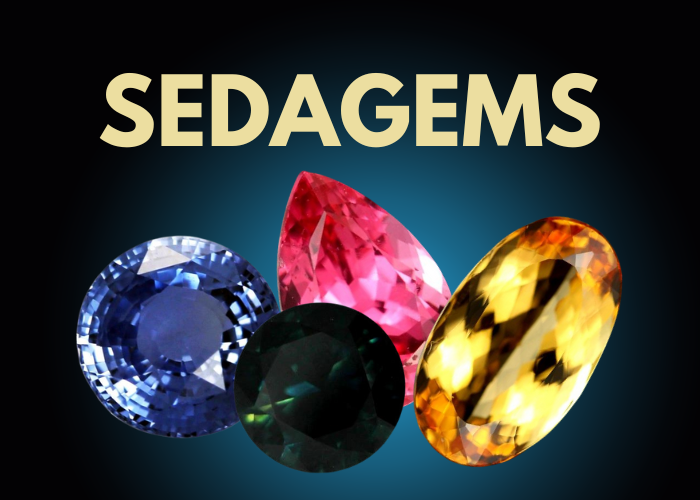Niste licitirali na ovoj dražbi.
20.65 CTS ALEXANDRITE - SPECIMEN FROM TANZANIA [S-SAFE260]
- SKU
- Dimenzije (mm)
- 13.000 x 11.000 x 8.000mm
- Težina (cts)
- 20.650
- Tip
- Specimen
- Boje
-
ALEXANDRITE SPECIMEN
This is a natural untreated Alexandrite specimen from Tanzania which i bought from the miner on my last trip there. They are not suitable for faceting but can be cabbed or kept as a specimen.
The most sensational feature about this stone, however, is its surprising ability to change its colour. Green or bluish-green in daylight, alexandrite turns a soft shade of red, purplish-red or raspberry red in incandescent light. This unique optical characteristic makes it one of the most valuable gemstones of all, especially in fine qualities.
Alexandrite is very scarce: this is due to its chemical composition. It is basically a chrysoberyl, a mineral consisting of colourless or yellow transparent chrysoberyl, chrysoberyl cat’s eye and colour-changing alexandrite (also in cat’s eye varieties). It differs from other chrysoberyls in that it not only contains iron and titanium, but also chromium as a major impurity. And it is this very element which accounts for the spectacular colour change. Rarely, vanadium may also play a part. According to CIBJO nomenclature, only chrysoberyls displaying a distinct change of colour may be termed alexandrite.
Like many other gemstones, alexandrite emerged millions of years ago in a metamorphic environment. But unlike many others, its formation required specific geological conditions. The chemical elements beryllium (a major constituent in chrysoberyl) and chromium (the colouring agent in alexandrite) have contrasting chemical characteristics and do not as a rule occur together, usually being found in contrasting rock types. Not only has Nature brought these contrasting rock types into contact with each other, but a lack of the chemical element silica (the second most common element in the Earth’s crust) is also required to prevent the growth of emerald. This geological scenario has occurred only rarely in the Earth’s history and, as a result, alexandrite crystals are very scarce indeed.
- SKU
- Dimenzije (mm)
- 13.000 x 11.000 x 8.000 mm
- Težina (cts)
- 20.650
- Tip
- Specimen
- Boje
-
ALEXANDRITE SPECIMEN
This is a natural untreated Alexandrite specimen from Tanzania which i bought from the miner on my last trip there. They are not suitable for faceting but can be cabbed or kept as a specimen.
The most sensational feature about this stone, however, is its surprising ability to change its colour. Green or bluish-green in daylight, alexandrite turns a soft shade of red, purplish-red or raspberry red in incandescent light. This unique optical characteristic makes it one of the most valuable gemstones of all, especially in fine qualities.
Alexandrite is very scarce: this is due to its chemical composition. It is basically a chrysoberyl, a mineral consisting of colourless or yellow transparent chrysoberyl, chrysoberyl cat’s eye and colour-changing alexandrite (also in cat’s eye varieties). It differs from other chrysoberyls in that it not only contains iron and titanium, but also chromium as a major impurity. And it is this very element which accounts for the spectacular colour change. Rarely, vanadium may also play a part. According to CIBJO nomenclature, only chrysoberyls displaying a distinct change of colour may be termed alexandrite.
Like many other gemstones, alexandrite emerged millions of years ago in a metamorphic environment. But unlike many others, its formation required specific geological conditions. The chemical elements beryllium (a major constituent in chrysoberyl) and chromium (the colouring agent in alexandrite) have contrasting chemical characteristics and do not as a rule occur together, usually being found in contrasting rock types. Not only has Nature brought these contrasting rock types into contact with each other, but a lack of the chemical element silica (the second most common element in the Earth’s crust) is also required to prevent the growth of emerald. This geological scenario has occurred only rarely in the Earth’s history and, as a result, alexandrite crystals are very scarce indeed.
| Pružatelj usluge dostave | Dostava u Australia | Dostava u ostatak svijeta |
|---|---|---|
| FedEx | $12.00 / :dani dani | $39.00 / :dani dani |
|
:zemlja
FedEx je snižen na $12.00 na narudžbe s 2 ili više artikala
Ostatak svijeta
FedEx je snižen na $39.00 na narudžbe s 2 ili više artikala
|
||
| Registered Shipping | $9.00 / :dani dani | $16.00 / :dani dani |
|
:zemlja
Registered Shipping je snižen na $9.00 na narudžbe s 2 ili više artikala
Ostatak svijeta
Registered Shipping je snižen na $16.00 na narudžbe s 2 ili više artikala
|
||

-
 Pozitivan
PozitivanPaid and shipped - no feedback left after 100 days
-
 Pozitivan
PozitivanBeautiful agate piece , and as always fast efficient service from Sedagems
-
 Pozitivan
PozitivanNice
-
 Pozitivan
PozitivanGorgeous stones, very happy
-
 Pozitivan
PozitivanGorgeous stone, very happy
Zašto korisnici nadmašuju same sebe?
Kada se postavi ponuda, to je maksimalni iznos koji je korisnik spreman ponuditi za proizvod. Naš sustav će zatim automatski licitirati u ime tog korisnika, postupno povećavajući licitaciju kako bi zadržao svoju poziciju ponuditelja najviše, do navedenog maksimuma.
Kada postoji ikona koja označava "Automatsku ponudu", to znači da naš sustav aktivno daje ponude za korisnika na temelju njihove maksimalne ponude. Ovo se može činiti kao da korisnici sami sebe nadmašuju, ali to je jednostavno rezultat ažuriranja ponude sustava kako bi odražavala maksimalno ograničenje korisnika.











![22.9CTS VARASCITE 'SPIDER WEB' AUSTRALIA [MGW 4616]](https://liveplatforms-production.b-cdn.net/tenants/gr/uploads/images/490000-494999/490866/55236df10a48f.JPG?width=480&aspect_ratio=1001%3A1000)





